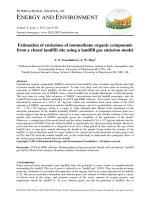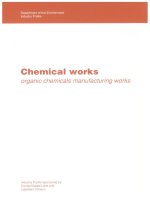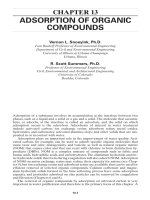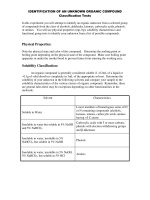Organic Compounds: Alkanes Alkanes ppt
Bạn đang xem bản rút gọn của tài liệu. Xem và tải ngay bản đầy đủ của tài liệu tại đây (564.71 KB, 44 trang )
Chapter 1 Notes
1
Chapter
1
Chapter
1
Mr. Kevin A. Boudreaux
Angelo State University
www.angelo.edu/faculty/kboudrea
Mr. Kevin A. Boudreaux
Angelo State University
www.angelo.edu/faculty/kboudrea
CHEM 2353
Fundamentals of Organic Chemistry
CHEM 2353
Fundamentals of Organic Chemistry
Organic Compounds:
Organic Compounds:
Alkanes
Alkanes
Organic and Biochemistry for Today
(4
th
ed.)
Spencer L. Seager / Michael R. Slabaugh
2
Organic chemistry nowadays
almost drives me mad. To
me it appears like a primeval
tropical forest full of the
most remarkable things, a
dreadful endless jungle into
which one does not dare
enter, for there seems to
be no way out.
Friedrich Wöhler
Chapter 1 Notes
3
4
What Do We Mean By
What Do We Mean By
“
“
Organic
Organic
”
”
?
?
• In everyday usage, the word organic can be found in
several different contexts:
– chemicals extracted from plants and animals were
originally called “organic” because they came
from living organisms.
– organic fertilizers are obtained from living
organisms.
– organic foods are foods grown without the use of
pesticides or synthetic fertilizers.
• In chemistry, the words “organic” and “organic
chemistry” are defined a little more precisely:
Chapter 1 Notes
5
What is Organic Chemistry?
What is Organic Chemistry?
• Organic chemistry is concerned with the study of
the structure and properties of compounds
containing carbon.
– All organic compounds contain carbon atoms.
– Inorganic compounds contain no carbons. Most
inorganic compounds are ionic compounds.
• Some carbon compounds are not considered to be
organic (mostly for historical reasons), such as CO,
CO
2
, diamond, graphite, and salts of carbon-
containing polyatomic ions (e.g., CO
3
2-
, CN
-
).
• Inorganic chemistry is the study of the other
elements and non-carbon containing compounds.
6
The Periodic Table
The Periodic Table
• There are 92 naturally occurring elements, and many
artificial ones, in the (in)famous Periodic Table:
K
Ca Sc
Ti
V
Cr Mn Fe Co
Ni
Cu Zn Ga Ge As Se Br Kr
Rb Sr
Y
Zr Nb
Mo Tc Ru
Rh
Pd
Ag
Cd
In Sn
Sb
Te
I
Xe
Cs Ba La
Hf
Ta
W
Re Os Ir Pt Au
Hg
Tl
Pb
Bi
Po
At
Rn
Ce Pr Nd Pm Sm
Eu
Gd
Tb
Dy
Ho
Er Tm Yb
Lu
Th
Pa
U
Np
Pu
Am
Cm
Bk
Cf
Es Fm
Md
No Lr
Na
Mg
Al Si
PS
Cl Ar
Li
Be
BCNOF
Ne
H
He
Fr Ra
Ac
Rf
Db
Sg
Bh
Hs
Mt
UunUuu
Uub
I A
II A
III B
IV B V B VI B VII B
III B
I B II B
III A IV A V A VI A VII A
VIII A
1
2
3
4
5
6
7
Lanthanides
Actinides
Uuq
Chapter 1 Notes
7
The Periodic Table of Organic Chemistry
The Periodic Table of Organic Chemistry
• Organic chemists look at the Periodic Table a little
differently:
Cr
Mn
Fe Co
Ni
Cu
Br
Pd
I
Pt
Mg
Al
PS
Cl
B
NOF
H
C
8
Origins of Organic Chemistry
Origins of Organic Chemistry
• Organic literally means “derived from living
organisms” — organic chemistry was originally the
study of compounds extracted from living organisms
and their natural products.
• It was believed that only living organisms possessed
the “vital force” necessary to create organic
compounds (“vitalism”).
• This concept started to change in 1828 after
Friedrich Wöhler showed that it was possible to
make urea, a known “organic compound” from a
mineral source:
NH
4
+
-
OCN
Heat
Ammonium
Cyanate Urea
C
O
NN
HH
HH
Chapter 1 Notes
9
Origins of Organic Chemistry
Origins of Organic Chemistry
• What this and later experiments showed was that
“organic” molecules — even those made by living
organisms — can be handled and synthesized just
like minerals and metals
• What was special about these molecules was that
they contained the element carbon.
10
What
What
’
’
s So Great About Carbon?
s So Great About Carbon?
• Carbons atoms can be linked by strong, stable
covalent bonds.
C
neutral carbon, C
C
carbon cation, C
4+
C
carbide anion, C
4-
C
H
H
H
H
C
H
H
HH
Chapter 1 Notes
11
What
What
’
’
s So Great About Carbon?
s So Great About Carbon?
• Carbon atoms can form stable bonds to many other
elements (H, F, Cl, Br, I, O, N, S, P, etc.). Most
organic compounds contain a few hydrogens, and
sometimes oxygen, nitrogen, sulfur, phosphorus, etc.
• Carbon atoms can form complex structures, such as
long chains, branched chains, rings, chiral
compounds (having a particular “handedness”),
complex 3D shapes, etc.
• Because of this variety in bonding and complexity,
carbon atoms can form a tremendous variety of
compounds. More than 16,000,000 organic
compounds are known, as opposed to about 600,000
inorganic compounds.
12
What
What
’
’
s So Great About Carbon?
s So Great About Carbon?
• Complex organic compounds can perform a number
of useful biological functions (vitamins,
carbohydrates, lipids, proteins, enzymes, ATP, DNA,
RNA are all organic compounds) which are studied
in biochemistry.
• Complex organic compounds are present in the foods
we eat (carbohydrates, proteins, fats, etc.)
•Most medicines, whether they come from a chemical
plant or a green plant, are organic compounds.
•Most fuels are organic compounds (wood, coal,
natural gas, gasoline, kerosene, diesel fuel, oil, and
other petroleum-based products).
• Complex organic compounds are also useful in
technology (paints, plastics, rubber, textiles, etc.).
Chapter 1 Notes
13
Organic vs. Inorganic Compounds
Organic vs. Inorganic Compounds
• Organic compounds are held together by covalent
bonds, while inorganic compounds are held together
by ionic bonds.
C
H
H
HH
methane
sodium chloride
Na
+
Cl
–
Na
+
Cl
–
Na
+
Cl
–
C
H
H
HH
Na
+
Cl
–
Na
+
Na
+
Cl
–
C
H
H
HH
Cl
–
Na
+
Cl
–
Cl
–
Na
+
14
Organic vs. Inorganic Compounds
Organic vs. Inorganic Compounds
ConductorNonconductor
Conductivity of
aqueous solutions
Often highOften lowSolubility in water
Usually
nonflammable
Often flammableFlammability
Usually high melting-
point solids
Gases, liquids, or low
melting-point solids
Normal physical state
Quite strongGenerally weak
Forces between
molecules
Often ionicUsually covalent
Bonding within
molecules
InorganicOrganicProperty
Table 1.1 Properties of typical organic and
inorganic compounds.
Chapter 1 Notes
15
16
Atomic Orbitals on Carbon
Atomic Orbitals on Carbon
• A carbon atom does not form ions easily, since it has
four valence electrons (1s
2
2s
2
2p
2
). It satisfies the
octet rule in compounds by sharing electrons.
• These are the orbitals that exist on atomic carbon
(not connected to anything).
s orbital
p orbital
2s
2p
Energy
1s
Chapter 1 Notes
17
Hybrid Orbitals
Hybrid Orbitals
• When carbon atoms form bonds with each other, we
describe the resulting bonds using hybrid orbitals,
which are formed by mixing (hybridizing) the
carbon’s atomic orbitals. (Linus Pauling, 1950s)
• When carbon atoms bond to 4 other atoms, the 2s
and all three 2p orbitals in the valence shell combine
to produce four sp
3
orbitals:
+ ++ +++
2s 3 ( 2p )
4 sp
3
atomic orbitals hybrid orbitals
18
2s
2p
Energy
1s
sp
3
1s
hybridization
Hybrid Orbitals
Hybrid Orbitals
• All four sp
3
orbitals are at the same energy level,
with one electron in each hybrid orbital.
Chapter 1 Notes
19
The Shape of an sp
The Shape of an sp
3
3
Carbon
Carbon
• In order to get as far away from each other as
possible (thus minimizing electron-electron
repulsions), the sp
3
orbitals are arranged in the shape
of a tetrahedron around the central carbon atom,
with bond angles of 109.5º.
CC
109.5°
sp
3
sp
3
sp
3
sp
3
20
The Shape of an sp
The Shape of an sp
3
3
Carbon
Carbon
Chapter 1 Notes
21
Bonding in Ethane
Bonding in Ethane
• Bonds arise from the overlap of orbitals on adjacent
atoms.
– End-on-end overlap of sp
3
orbitals produces a σ-
bond (sigma bond).
– All single bonds are σ-bonds.
– Free rotation is possible around σ-bonds.
• Each carbon in the ethane molecule, CH
3
CH
3
, is sp
3
-
hybridized and tetrahedral in shape. Free rotation is
possible around the C—C bond. (See next slide)
22
Bonding in Ethane
Bonding in Ethane
Chapter 1 Notes
23
Carbon Chains
Carbon Chains
• Each carbon atom can form four bonds, either to
other carbon atoms, or to different atoms (such as H,
O, N, S, P, etc.)
=
CC
Th
r
ee
m
o
r
esi
t
es
to make bonds
C
C
CC
CCC
C
CCCC
C
CCCC
C
C
e
t
c.
24
Multiple Bonds
Multiple Bonds
• Carbon atoms form four bonds to other things, but
sometimes those bonds are multiple bonds (double
or triple bonds):
CCCC
triple bond
results from the sharing
of six electrons
CCCC
CCCC
double bond
results from the sharing
of four electrons
single bond
results from the sharing
of two electrons
Chapter 1 Notes
25
Isomers
Isomers
• Isomers — compounds having identical molecular
formulas, but different arrangements of atoms.
• Structural Isomers — the atoms in each molecule
are connected in a different order.
C
2
H
6
O
CH
H
H
C
H
H
OH OCCH
H
H
H
H
H
Ethyl Alcohol Dimethyl Ether
Intoxicant
density 0.789 g/mL (20°C)
bp 78.5°C
mp -117°C
Colorless liquid
Refrigerant
density 0.00195 g/mL (20°C)
bp -25°C
mp -139°C
Colorless gas
26
Examples: Isomers
Examples: Isomers
• Draw all possible structures having the formulas
C
4
H
10
, C
5
H
12
, and C
6
H
14
.
C
7
H
16
9 isomers
C
8
H
18
13 isomers
C
9
H
20
35 isomers
C
10
H
22
75 isomers
C
20
H
42
366,319 isomers
C
30
H
62
4,111,846,763 isomers!
C
40
H
82
62,481,801,147,341 isomers!
Chapter 1 Notes
27
Examples: Isomers
Examples: Isomers
• Which of the following
molecules is a structural
isomer of acetone?
CH
3
C
O
CH
3
Ace
t
one
H
2
CCHCH
2
OH
H
3
CCH
2
C
O
OH
H
2
CCHC
O
H
H
3
CCH
2
C
O
H
28
Functional Groups
Functional Groups
• Organic molecules are often organized by structures
called functional groups, which are characteristic
arrangement of atoms which define many of the
physical and chemical properties of a class of
organic compounds.
– The simplest of the functional groups are the
hydrocarbons, which include the alkanes,
alkenes, alkynes, and aromatic hydrocarbons.
– Many functional groups contain oxygen atoms,
such as alcohols, ethers, aldehydes, ketones,
carboxylic acids, and esters.
– Some other functional groups contain nitrogen
atoms, such as the amines and amides.
• Molecules with the same functional group tend to
share similar chemical and physical properties.
Chapter 1 Notes
29
Table 1.2 Classes and functional groups of organic compounds
Class
Functional Group
Example of expanded
structural formula
Example of condensed
structural formula
IUPAC / Common name
Alkane None H C
H
C
H
H
H
H
CH
3
CH
3
ethane
Alkene
ethene (ethylene)
CC C
H
H
C
H
H
H
2
CCH
2
Alkyne
ethyne (acetylene)
CC CC
HC CH
HH
Aromatic
CC
C
CC
C
CC
C
CC
C
HH
HH
HH
benzene
Alcohol C O H CCOH
H
HH
H
H
CH
3
CH
2
OH ethyl alcohol
Ether
COC OCCH
H
H
H
CH
3
OCH
3
methoxymethane
(dimethyl ether)
H
H
30
N
H
HAmine CHNH
H
H
H
CH
3
NH
2
methylamine
Aldehyde
Ketone
Carboxylic acid
Ester
Amide
C
O
HCC
O
H
CC
O
C
C
O
O
C
O
O
C
O
N
H
H
H
CC
O
C
H
H
HH
H
H
C
CC
O
OH
H
H
H
CC
O
O
H
H
HC
H
H
CC
O
N
H
H
H
H
CH
3
CH
O
CH
3
CCH
3
O
CH
3
COH
O
CH
3
COCH
3
O
CH
3
CNH
2
O
ethanal (acetaldehyde)
2-propanone (acetone)
ethanoic acid (acetic acid)
methyl ethanoate
(methyl acetate)
ethanamide (acetamide)
H
H
H
Table 1.2 Classes and
f
unctional groups o
f
organic compounds
Class
Functional Group
Example of expanded
structural formula
Example of condensed
structural formula
IUPAC / Common name
Chapter 1 Notes
31
32
A Moderately Complex Organic Molecule
A Moderately Complex Organic Molecule
C
C
C
C
C
C
C
C
C
CC
C
C
C
C
C
C
C
C
HO
C
C
C
C
C
C
C
C
H
H
H
H
H
H
H
H
HH
H
H
H
H
H
H
H
H
H
H
H
H
H
H
H
H
H
H
H
H
H
H
H
H
H
H
H
H
H
H
H
H
H
H
H
Chapter 1 Notes
33
Expanded Structural Formulas
Expanded Structural Formulas
•In expanded structural formulas (Lewis formulas,
Lewis structures), all atoms and bonds are shown:
HCO
H
H
CH
H
H
HCC
H
H
O
H
H
H
HCC
H
C
H
H
H
H
HCC
H
H
H
H
H
34
Condensed Structural Formulas
Condensed Structural Formulas
•In condensed structural formulas, only specific
bonds are shown; this is useful in reducing the
number of C—H bonds that must be drawn.
H
3
CCH
3
CH
3
CH
3
CH
3
CH
3
CH
2
CH CH
3
CH
3
CH
2
CH
3
CH
2
OH
OH
CH
3
CH
2
CH
3
CH
2
OCH
2
CH
3
OCH
2
CH
3
Chapter 1 Notes
35
Line Drawings
Line Drawings
•In line drawings (line-angle formulas, skeletal
structures, stick figures), bonds are represented by
lines; everywhere two lines meet or a line begins or
ends is a C atom. H’s on C’s are not shown (except
for emphasis); H’s on other atoms must be shown.
OH O
36
Drawing Organic Molecules
Drawing Organic Molecules
HCCCC
HHH
HHH
H
H
H
Expanded s
t
r
uc
t
u
r
al
f
o
r
m
ula
(Lewis structure)
CH
3
CH
2
CH
2
CH
3
Con
d
ense
d
s
t
r
uc
t
u
r
al
f
o
r
m
ulas
CH
3
CH
2
CH
2
CH
3
CH
3
(CH
2
)
2
CH
3
Line d
r
awing
=CH
3
= CH
2
= CH
= C
Chapter 1 Notes
37
C
C
C
C
C
C
C
C
C
CC
C
C
C
C
C
C
C
C
HO
C
C
C
C
C
C
C
C
H
H
H
H
H
H
H
H
HH
H
H
H
H
H
H
H
H
H
H
H
H
H
H
H
H
H
H
H
H
H
H
H
H
H
H
H
H
H
H
H
H
H
H
H
Cholesterol
Cholesterol
Drawing Organic Molecules
Drawing Organic Molecules
Expanded Structural Formula
Expanded Structural Formula
38
Drawing Organic Molecules
Drawing Organic Molecules
CHCH
2
CH
2
CH
2
CH(CH
3
)
2
H
2
C
CH
C
H
2
C
C
H
2
C
C
H
CH
2
CH
CH CH
C
H
2
C
H
2
C
C
H
2
CH
2
CH
CH
3
CH
3
HO
CH
3
Condensed Structure
Condensed Structure
Chapter 1 Notes
39
Line Drawing
Line Drawing
Drawing Organic Molecules
Drawing Organic Molecules
HO
40
Examples: Drawing Organic Molecules
Examples: Drawing Organic Molecules
• Draw acceptable condensed structures and line
drawings associated with the following expanded
structural formulas.
C
H
H
H
CCCCH
HHH
H
C
H
H
HH
C
C
C
C
C
C
H
3
CCH
3
H
H
H
H
H
H
H
H
H
H
CHC
H
H
O
C
H
H
H
• Draw an acceptable expanded
structure and line drawing for
the molecule CH
3
CH
2
CH
2
OH.
Chapter 1 Notes
41
Examples: Drawing Organic Molecules
Examples: Drawing Organic Molecules
• Draw acceptable expanded structures, condensed
structures, and line drawings for the following
molecules:
– isopropyl alcohol, CH
3
CH(OH)CH
3
– acetic acid, CH
3
COOH
– acetaldehyde, CH
3
CHO
– acetone, CH
3
COCH
3
42
Chapter 1 Notes
43
44
Hydrocarbons
Hydrocarbons
• Hydrocarbons — compounds that contain only
carbon and hydrogen.
• Saturated Hydrocarbons — contain only carbon-
carbon single bonds.
• Unsaturated Hydrocarbons — contain carbon-
carbon double or triple bonds.
C
H
H
HC
H
H
H
Al
k
anes
C
H
H
C
H
H
CHCH
C
C
C
C
C
C
H
H
H
H
H
H
Alkenes
Alkynes
A
r
o
m
a
t
ics
Chapter 1 Notes
45
Alkanes
Alkanes
• Alkanes are saturated hydrocarbons — each carbon
holds the maximum number of hydrogen atoms).
– Alkanes contain only carbon-carbon single bonds.
– General formula: C
n
H
2n+2
(no rings).
• Most chemical reactions require a functional group
“handle” to proceed. Since alkanes don’t really have
functional groups, they aren’t very useful in many
biologically important processes.
– Since alkanes undergo combustion easily, they
are a good source of energy (e.g., gasoline).
– Alkanes also provide the raw materials for the
production of many other more complex
substances (plastics, etc.).
46
Some Common Alkanes
Some Common Alkanes
• Methane, CH
4
– major component of natural gas (~85%), which is
produced by bacterial decomposition of
organisms in the absence of oxygen (marsh gas,
cow flatulence).
– burns cleanly, so is useful for cooking.
– odorless — ethanethiol is added to make natural
gas leaks detectable.
• Ethane, CH
3
CH
3
(C
2
H
6
) — a minor component of
natural gas (~10%).
• Propane, CH
3
CH
2
CH
3
(C
3
H
8
) — used as an
industrial fuel, and in home heating and cooking.
Chapter 1 Notes
47
Some Common Alkanes
Some Common Alkanes
• Butane, CH
3
CH
2
CH
2
CH
3
(C
4
H
10
)
– cigarette lighters
– Butane is an unbranched (normal) alkane.
There is also a branched alkane with the formula
C
4
H
10
, having a three-carbon chain with a one-
carbon group connected to the middle.
– We must give the other isomer a different name:
CH
3
CH(CH
3
)CH
3
[or CH
3
CH(CH
3
)
2
] is named
isobutane (or 2-methylpropane).
– Butane and isobutane are structural isomers of
each other.
Bu
t
ane
Iso
b
u
t
ane
CH
3
CH
2
CH
2
CH
3
CH
3
CHCH
3
CH
3
48
Conformations of Alkanes
Conformations of Alkanes
• Conformation — the different arrangements of
atoms in space achieved by rotation about single
bonds.
• Structures which are related to each other by rotation
around a single bond are the same molecule.
CH
3
HH
CH
3
HH
CH
3
HH
H
HCH
3
CH
3
HH
H
CH
3
H
CH
3
HH
CH
3
HH
CH
3
CH
3
H
HH
H
CH
3
H
H
H
H
CH
3
CH
3
CH
2
CH
2
CH
3
Chapter 1 Notes
49
Examples: Conformations and Isomers
Examples: Conformations and Isomers
• Which of the following groups represent structural
isomers, and which are simply the same compound?
CH
3
CH
2
CH
2
CH
3
CH
3
CH
2
CH
2
CH
3
CH
3
CH
2
CH
2
CH
3
CH
3
CH
2
CH
2
CH
3
CH
CH
3
CH
3
CH
3
CH
2
CH
2
CH
2
CH
2
CH
2
CH
2
CH
2
CH
2
CH
3
CH
3
CH
3
CH
3
CH
2
CH
2
CH
3
CH
3
50
Examples: Conformations and Isomers
Examples: Conformations and Isomers
• Which of the following groups represent structural
isomers, and which are simply the same compound?
CH
3
CH
CH
3
CH
3
CH
3
CH
CH
3
CH
3
CH
3
CH
2
CH CH
3
CH
3
CH
3
CH
CH
3
CH
2
CH
3
CH
3
CCH
3
CH
3
CH
3
CH
3
CH CH
3
CH
2
CH
3
CH
3
CH
CH
3
CH
2
CH
3
CH
3
CH CH
2
CH
3
CH
2
CH
3
CH
3
CH
2
CH
CH
3
CH
2
CH
3









